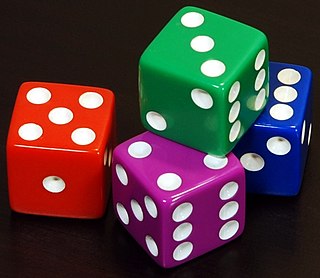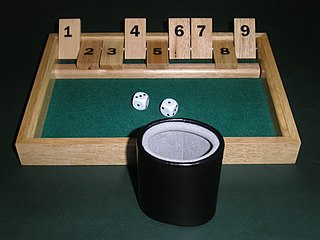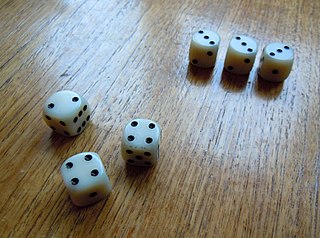
Craps is a dice game in which the players make wagers on the outcome of the roll, or a series of rolls, of a pair of dice. Players may wager money against each other or a bank. Because it requires little equipment, "street craps" can be played in informal settings. While shooting craps, players may use slang terminology to place bets and actions.

Dice are small, throwable objects with marked sides that can rest in multiple positions. They are used for generating random numbers, commonly as part of tabletop games, including dice games, board games, role-playing games, and games of chance.

Yahtzee is a dice game made by Milton Bradley, which was first marketed as Yatzie by the National Association Service of Toledo, Ohio, in the early 1940s. It was marketed under the name of Yahtzee by game entrepreneur Edwin S. Lowe in 1956. The game is a development of earlier dice games such as Poker Dice, Yacht and Generala. It is also similar to Yatzy, which is popular in Scandinavia.

Shut the box, also called Blitz, Canoga, klackers, batten down the hatches, kingoball, trictrac, cut throat, fork your neighbor, and jackpot, is a game of dice for one or more players, commonly played in a group of two to four for stakes. Traditionally, a counting box is used with tiles numbered 1 to 9 where each can be covered with a hinged or sliding mechanism, though the game can be played with only a pair of dice, pen, and paper. Variations exist where the box has 10 or 12 tiles. Alternatively, dominoes can be used for the tiles - this also provides the option of using up to six dice if a Double 18 domino set is used. A deck of cards can also be used as tiles, and if so desired a complete conventional Western deck with the jokers can provide for the use of up to nine dice. As described below under Variants, the dominoes or cards can also be used in place of the dice if so desired.

Pig is a simple dice game first described in print by John Scarne in 1945. Players take turns to roll a single die as many times as they wish, adding all roll results to a running total, but losing their gained score for the turn if they roll a 1.
Liar's dice is a class of dice games for two or more players requiring the ability to deceive and to detect an opponent's deception.
Cee-lo is a gambling game played with three six-sided dice. There is not one standard set of rules, but there are some constants that hold true to all sets of rules. The name comes from the Chinese Sì-Wŭ-Liù (四五六), meaning "four-five-six". In America it is also called "See-Low," "Four-Five-Six," "The Three Dice Game," "Roll-off!," and by several alternative spellings, as well as simply "Dice." In China it is also called "Sān Liù Bàozi" (三六豹子), or "Three-Six Leopards". In Japan, it is known as "Chinchiro" (チンチロ) or "Chinchirorin" (チンチロリン).
Farkle, or Farkel, is a dice game has also been called or is similar to 1000/5000/10000, Cosmic Wimpout, Greed, Hot Dice, Squelch, Zilch, or Zonk. Its origins as a folk game are unknown, but the game dates back to at least the mid 1980s. It has been marketed commercially since 1996 under the brand name Pocket Farkel by Legendary Games Inc. While the basic rules are well-established, there is a wide range of variation in both scoring and play, as described below.
Dice chess can refer to a number of chess variants in which dice are used to alter gameplay; specifically that the moves available to each player are determined by rolling a pair of ordinary six-sided dice. There are many different variations of this form of dice chess. One of them is described here.

Dice 10,000 is the name of a family dice game, it is very similar to farkle. It also goes by other names, including Zilch, Zilchers, Foo, Boxcar, Bogus, Zach’s Dice Game, and Crap Out.
Mexico is an elimination-style dice game, in which several players agree to play a set number of rounds. After each round, one player is eliminated. When all players but one have been eliminated, the remaining player wins the game. Owing to its extremely simple play-structure, it is generally pursued as a method of gambling, whereby the final remaining player wins the amount of money wagered by each person who was eliminated in earlier rounds. A variant of the drinking game liar's dice known as Mexican or Mia uses similar dice rolls, but has very different game mechanics.

Sicherman dice are the only pair of 6-sided dice that are not normal dice, bear only positive integers, and have the same probability distribution for the sum as normal dice.

EinStein würfelt nicht! is a board game, designed by Ingo Althöfer, a professor of applied mathematics in Jena, Germany. It was the official game of an exhibition about Einstein in Germany during the Einstein Year (2005).
Dice notation is a system to represent different combinations of dice in wargames and tabletop role-playing games using simple algebra-like notation such as 2d6+12.

Poker dice are dice which, instead of having number pips, have representations of playing cards upon them. Poker dice have six sides, one each of an Ace, King, Queen, Jack, 10, and 9, and are used to form a poker hand.

Bradley Efron is an American statistician. Efron has been president of the American Statistical Association (2004) and of the Institute of Mathematical Statistics (1987–1988). He is a past editor of the Journal of the American Statistical Association, and he is the founding editor of the Annals of Applied Statistics. Efron is also the recipient of many awards.

KDice is a browser-based multiplayer strategy game based on Taro Ito's Dice Wars. KDice is programmed in Adobe Flash and AJAX by Ryan Dewsbury and was released in 2006. Gameplay in KDice is a simplified version of Risk with the primary goal of the game being to control every territory on the map.

Miwin's Dice are a set of nontransitive dice invented in 1975 by the physicist Michael Winkelmann. They consist of three different dice with faces bearing numbers from 1 to 9; opposite faces sum to 9, 10, or 11. The numbers on each die give the sum of 30 and have an arithmetic mean of 5.
Midnight is a dice game played with 6 dice.

































